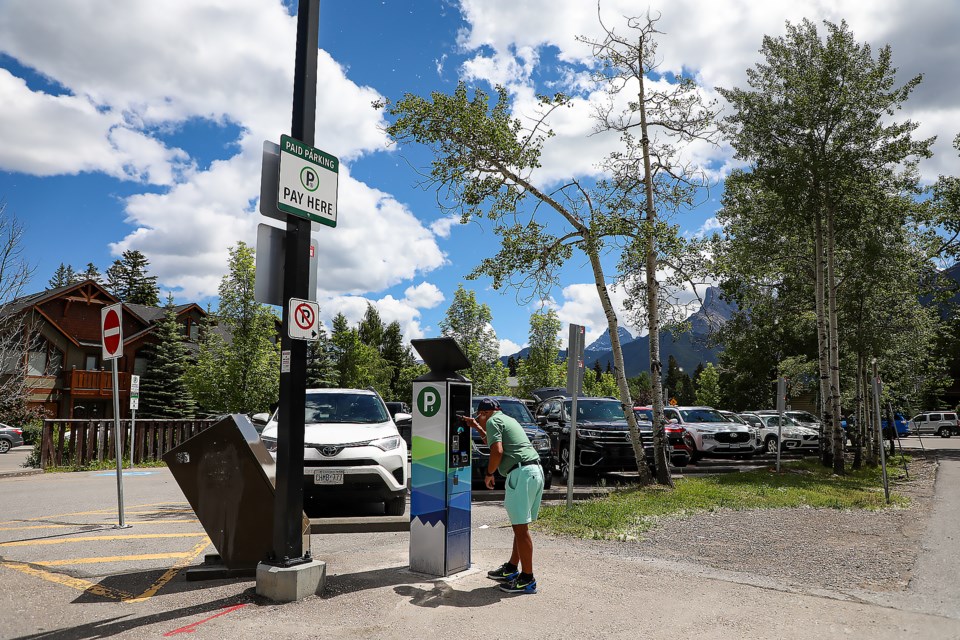CANMORE – More than $700,000 from paid parking fees was collected for Town of Canmore coffers in 2022.
According to the annual staff report on paid parking, $881,000 of the $1.075 million in gross revenue was collected from the Town Centre and another $193,000 in gross revenue from Quarry Lake – well above the projected gross revenue of $695,000 and leaving $706,000 in net revenue.
Though bringing in an added source of revenue for the Town of Canmore, a key element of the paid parking program is designed to align with the municipality's goal of reaching 40 per cent of non-vehicle travel by 2030. In addition to having free public bus transit in Canmore, infrastructure projects have focused on active modes of transit rather than just prioritizing vehicle travel.
“As part of the measuring process in council’s strategic plan and looking at key results and objectives as reviewed with council, one of the key results we’re looking at tracking is progress in mode shift as it relates to council’s environment goal,” said Whitney Smithers, the Town’s general manager of municipal infrastructure, adding more information will be provided on those numbers in the coming weeks.
At the 2022 and 2023 budget deliberations, Canmore council set aside money from paid parking to help cover a portion of costs associated with having free Roam public transit.
Andy Esarte, the Town’s manager of engineering, said staff track areas of town to examine the mode shift switch but not for the entire community. However, trends are able to be found and analyzed.
“We’re able to see trends in how things are changing at those points in the downtown and we’re also able to track transit usage and we can endeavor to use some of those statistics in the parking utilization report,” he said.
For some in the community, paid parking has been a controversial addition. While all residents are eligible for three hours of free parking per day, information showed residents paid $5,210 in the off peak season and $6,414 in peak season.
The downtown program also allowed for monthly resident parking permits, but only 17 were sold. However, residents used more than 120,000 hours of free paid parking that would’ve been about $300,000 in gross revenue in the downtown core without the three free hours of parking per day.
In Quarry Lake, residents used slightly more than 22,385 free hours of parking.
Danielle Liwanag, the Town’s paid parking coordinator, said an educational approach was taken at the beginning of the downtown program; however, it was difficult because it could only happen if the driver was still at or near their vehicle.
“Any time there’s a driver coming, leaving or near their vehicle and see they’re getting a ticket, if they come and let our parking staff know it’s their car, they will always explain what happened, always let them know how they can pay before issuing a ticket,” she said.
There were 543 warnings issued and 5,880 tickets handed out, with non-residents accounting for 87 per cent of those tickets. According to the report, verbal warnings weren’t calculated.
Enforcement takes place seven days a week between 8 a.m. and 8 p.m., but there’s a higher staff presence Fridays to Sundays.
If there’s a system outage on the Blinkay app, enforcement wouldn’t take place. Liwanag said that has only happened twice and impacted Blinkay’s entire network, once in February and the other during the Rogers outage last July.
There were slightly more than 12,200 resident permits approved – including 513 to businesses – while 600 ticket appeals were made and 292 granted. A total of 968 emails, phone calls and in-person contacts were answered by paid parking staff.
The report highlighted additional steps that could be taken after receiving feedback. Among those are installing more signage, undergo a parking study to look at paid parking in relation to the Integrated Parking Management plan, installing more pay machines and changing staff scheduling to have more available on busier days.




